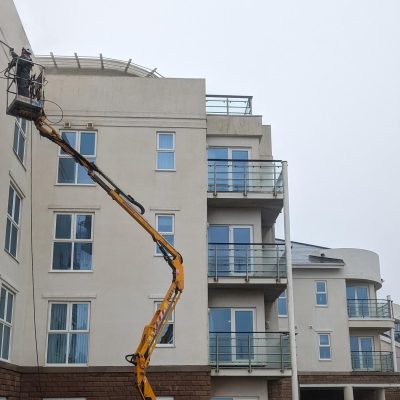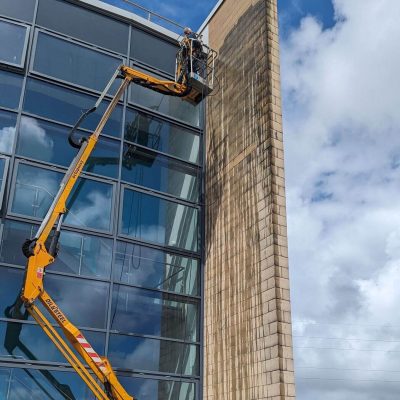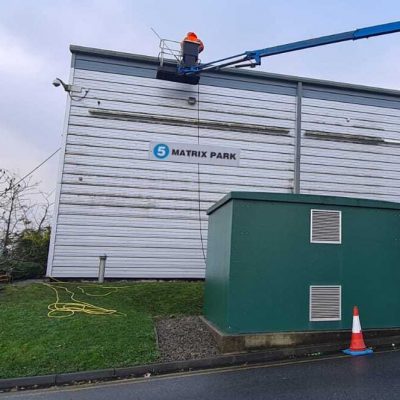Operating an access platform, also known as a mobile elevating work platform (MEWP), can seem daunting if you’ve never done it before. However, with the right training and preparation, anyone can learn to safely and efficiently operate these incredibly useful machines.
In this blog post, We’ll provide a comprehensive overview of everything you need to know before operating a Mobile Elevated Work Platform for the first time.
Choosing the Right Access Platform
There are several different types of access platforms. Each suited for specific applications and situations. The most common types include:
- Scissor Lifts – Compact and manoeuvrable with work heights up to 50 feet. Best for indoor use on flat, hard surfaces.
- Boom Lifts – Feature an articulating arm and can reach up to 150 feet. Ideal for outdoor use on uneven terrain.
- Vertical Lifts – Offer working heights up to 130 feet but a very compact footprint. Best for tight indoor spaces.
- Hybrid Lifts – Combine capabilities of both scissors and boom lifts. Can be driven whilst lifted.
- Trailer Mounted Lifts – Attached to a vehicle for easy transportation between work sites.
Consider the type of environment you’ll be working in, the height you need to reach, and any site access restrictions to choose the right platform. Your rental company can advise on the best option.
Inspection & Operation
Familiarise yourself with the specific mobile elevating work platform you’ll be using. Read the instruction manual and control labels, and complete a thorough pre-operation inspection including:
- Tires – Check for proper pressure and tread.
- Hydraulic components – Inspect for leaks.
- Control mechanisms – Test all buttons and pedals.
- Safety devices – Ensure horn, alarms and lights function properly.
- Fluid levels – Top up fuel, hydraulic oil as required.
- Structural components – Look for loose or damaged parts.
- Guardrails – Must fully enclose the platform.
Advisable to operate the machine only if everything checks out.
And please DO NOT PARK like this:
Using the Controls
Most access platforms have fairly intuitive controls similar to a forklift. Mastering the precise control motions will take practice. Most units have:
- Drive pedal – For forward/reverse motion of the chassis.
- Lift/Lower control – Raises or lowers work platform.
- Boom swing control – Manoeuvres articulating arm (on boom lifts).
- Deadman switch – Stops operation if released.
Go through the motions slowly, first on the ground, then at low heights until the controls become second nature. Don’t rush – precision is key.
Worksite Assessment
Thoroughly examine the worksite before using an access platform. Look for potential hazards like:
- Drop-offs or holes
- Bumps, debris or uneven ground
- Slopes and inclines
- Overhead obstacles like branches or powerlines
- Ground/surface composition and firmness
- Traffic and pedestrians
Identify a clear, levelled area for operation. Check for adequate clearance from buildings, vehicles or other structures. Barricade the workspace if needed.
Fall Protection
Working at height presents an obvious fall hazard. Access platforms are designed to prevent falls when used properly, but extra precautions should still be taken:
- Wear an approved safety harness securely tethered to the platform.
- Keep your feet firmly on the platform floor at all times. Never stand on rails or use planks for extra height.
- Don’t exceed the platform’s weight capacity. This shifts the centre of gravity.
- Position the platform directly over the working area. NEVER OVERREACH.
- Never climb down from a raised platform.
- Lower the platform fully before exiting.
Following these basic rules will help prevent potentially fatal falls.
Electrical Safety
Access platforms don’t mix well with electricity. Crane arms can easily contact overhead power lines, sending deadly current through the machine.
Check for any overhead or nearby power lines before raising the platform. Use a spotter on the ground if visibility is limited. Maintain minimum safe approach distances – refer to the operator’s manual for guidance.
If the platform contacts live lines, stay calm and don’t jump out. Carefully manoeuvre away from the lines if possible. Otherwise, remain in place and call for emergency assistance. Do not attempt to climb down until utility workers confirm it is safe to do so.
Tip-Over Prevention
MEWPs can rapidly tip over if operated incorrectly, with fatal consequences. The most common causes of tip-overs include:
- Excessive Sideways Forces – Avoid pushing or pulling objects from an elevated platform. The force can shift the centre of gravity outside the stability footprint.
- Sudden Platform Jolts – Smoothly accelerate from a stop and avoid abrupt motions of the boom or platform. Take care when attaching loads.
- Platform Overloading – Ensure the combined weight of occupants and tools doesn’t exceed capacity. Larger platforms may have tiered capacity ratings.
- Working on Slopes – Only drive straight up or down a slope. Never raise the platform on any incline exceeding the machine’s rated gradeability.
- Driving Too Fast – Rapid acceleration, deceleration and turning creates centrifugal forces that can tip machines. Go slowly!
Also, lower the platform fully before driving and never tie off platforms to nearby structures. Take tip-over risks seriously.
Slinger Signaller Communication
Having a trained slinger signaller or spotter on the ground is mandatory for some access platform operations. Even when not legally required, it’s a good idea to use one whenever visibility is limited or the area is congested.
Agree on hand signals beforehand. Common slinger signaller gestures include:
- Circular motion above head = Raise platform
- Arm extended, moving up and down = Lower platform
- Thumbs up = Operation OK, proceed
- Crossed arms above head = Emergency stop!
- Waving arms = Move in direction waved
The signaller should be in the operator’s line of sight at all times. If visual contact is lost, stop moving immediately until it’s re-established.
Transport and Lifting
When transporting access platforms between sites, follow these safety guidelines:
- Platform should be fully lowered and retracted into a transport position.
- Remove all loose tools or materials from the platform.
- Drive slowly and avoid sudden braking or sharp turns.
- Use caution on slopes, curbs and rough terrain.
Some larger machines need loading onto a truck or trailer via ramps or a crane. Secure the platform against rolling and verify all lift slings are properly balanced and rated for the weight. Use tag lines for better control. Only lift under supervision of a qualified rigger or transport operator.
Finishing Up
Once work is completed, take a moment to survey the platform and worksite:
- Collect and properly store all tools that were used. Don’t leave anything on the platform.
- Check beneath the machine for leaks that may have developed.
- Ensure guardrails, controls and safety devices are undamaged.
- Fully lower and stow the platform into driving position. Slowly drive back to the storage location.
- Charge batteries if needed or refuel the engine.
- Report any issues or damage to the rental company upon return.
Proper platform shutdown and cleanup helps prevent accidents for the next operator.
By following these usage guidelines and making safety your top priority, you can operate an access platform with skill and confidence.
Don’t hesitate to ask for help or clarification from experienced workers whenever unsure. Working at height requires constant vigilance – stay focused.



